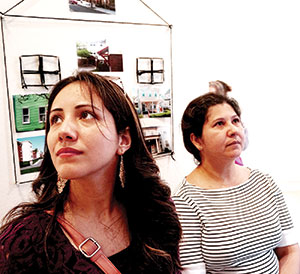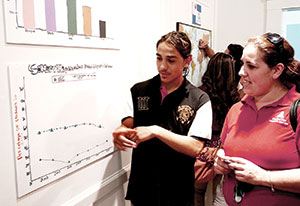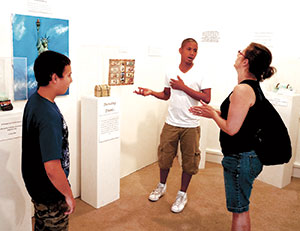 By Sanjeev Selvarajah
By Sanjeev Selvarajah
How can anyone remain political about a hot button issue when seeing an investment coming from the disenfranchised voice of the population being examined?
Are hard-working young 8th-grade adolescents without a voice: can you tell these youngsters “No, sorry—you’re just a statistic?” Laura Hoguet, Social Studies teacher of Healey School’s 8th grade class, wants her students to open the minds of adults: the seniors, the established, and the oh, so very political hierarchy of their neighbors, from all walks of life, across borders of minds and geography.
Come check out Somerville Museum’s episodic series Project Local. This portion dissects the Immigrant Dreams and Realities in Somerville, open until Saturday June 28. See for yourself what Somerville’s next generation has in store.
Two of the greatest humanist traits of the United States of America are one, the principle of free-speech (everybody is entitled to their opinion), to two, this great nation is historically a hub for immigration. “In class, students are able to share their heritage and whether students are recent immigrants or their families have been here for hundreds of years, we find a common ground in having ancestors who immigrated at some point,” says Ms. Hoguet.
 A challenge for any teacher is to be both profound and specific about everything from examples to general scholarship, such as research and the often maligned blessing of creativity. There is room for interpretation as well, and Laura Hoguet instructed her class to discover the virtues of both artistic expression, as well as art criticism.
A challenge for any teacher is to be both profound and specific about everything from examples to general scholarship, such as research and the often maligned blessing of creativity. There is room for interpretation as well, and Laura Hoguet instructed her class to discover the virtues of both artistic expression, as well as art criticism.
“The Healey School is a project based learning and arts integration school, so building a museum exhibit was the perfect project for our immigration unit. I contacted the Somerville Museum to help brainstorm some ideas and they graciously gave us exhibit space and helped facilitate building the exhibit,” says Laura.
Another great resource for these students of Somerville is Michael O’Connell of the Somerville Museum. Mr. O’Connell was kind enough to spare some time to elaborate on his perspective of young Somerville academia: “The most important thing for me to remember as the representative of the Somerville Museum is to give the young students the space to find the answers for themselves, in order to maintain the museum as a learning environment rather than as a dispenser of knowledge about Somerville history. The students choose the theme, do the research, design the exhibit and install the display together with me in the museum. Their teacher and I can coach, while making it clear that the students own the research and own the exhibit. The experience becomes important both as a way of teaching local history, but also as a training tool in how to collaborate and work towards a common goal as a group process. That’s a lesson in citizenship. And how to take responsibility. That’s a lesson in personal development.”
Laura Hoguet was quick to point out that arriving immigrants weren’t automatically given a wreath of laurel upon entering the States—a struggle was afoot—hardship was bound to test human dignity. “One of my goals of the project was to get the students learning of the real-world challenges of immigrating to America and then raising questions about how they can help ameliorate the situation.”
What changes would this next generation go through that might alter their perspective? What relationship could be forged between the locals and the arriving? Laura Hoguet shed some light, “They are an incredibly hopeful and optimistic group of students who embrace each other for who they are, which is rare for 8th grade students. Through this project, they learned of many immigrants’ struggles with moving to Somerville.”
Mr. O’Connell swelled with pride and satisfaction of working with both  Laura and her students: “One significant impact of the Somerville Museum is its unique ability as a platform for community interests to connect the disparate elements within Somerville. The opening reception for the Project LOCAL: Immigrant Dreams and Realities in Somerville provided another great example of that.” During the opening reception early last week nearly 200 members of the public banded together to share a small fraction of their time and a large dose of their spirit.
Laura and her students: “One significant impact of the Somerville Museum is its unique ability as a platform for community interests to connect the disparate elements within Somerville. The opening reception for the Project LOCAL: Immigrant Dreams and Realities in Somerville provided another great example of that.” During the opening reception early last week nearly 200 members of the public banded together to share a small fraction of their time and a large dose of their spirit.
For more information, such as hours, and a description of this exhibit go to http://somervillemuseum.org/.












Reader Comments